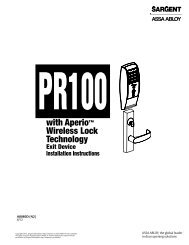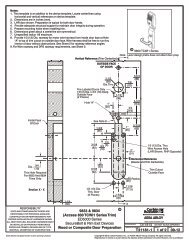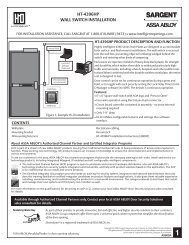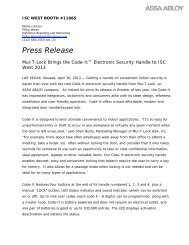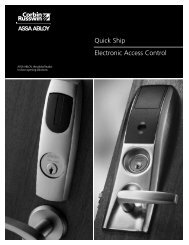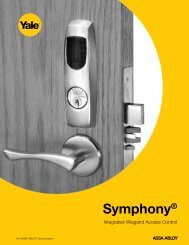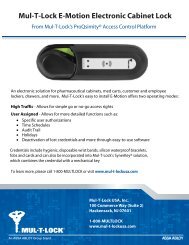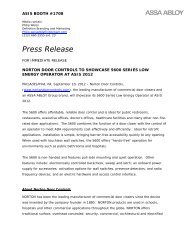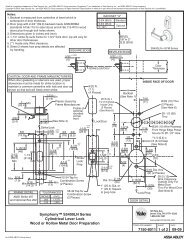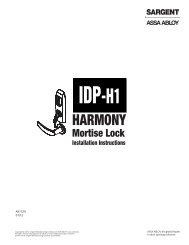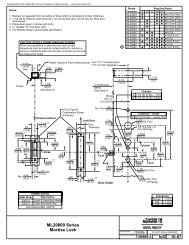SE LP10 - Access Control Solutions from ASSA ABLOY
SE LP10 - Access Control Solutions from ASSA ABLOY
SE LP10 - Access Control Solutions from ASSA ABLOY
You also want an ePaper? Increase the reach of your titles
YUMPU automatically turns print PDFs into web optimized ePapers that Google loves.
1<br />
2<br />
3<br />
4<br />
5<br />
6<br />
7<br />
8<br />
9<br />
10<br />
Table of Contents<br />
Warning ....................................................................................3<br />
General Description..................................................................4<br />
Technical Specifications..........................................................4<br />
Electrical Specifications...........................................................4<br />
Parts Breakdown......................................................................5<br />
Installation Instructions...........................................................7<br />
Wiring Diagrams.....................................................................15<br />
UL294 Compliance..................................................................18<br />
Mechanical Operational Check..............................................19<br />
Electrical Operational Check..................................................19<br />
Copyright © 2014, Sargent Manufacturing Company, an <strong>ASSA</strong> <strong>ABLOY</strong> Group company. All rights reserved.<br />
Reproductions in whole or in part without express written permission of Sargent Manufacturing Company is prohibited.<br />
02/15/14<br />
1<br />
Warning<br />
!!<br />
Changes or modifications to this unit not expressly approved by the party<br />
responsible for compliance could void the user’s authority to operate the equipment.<br />
FCC:<br />
This equipment has been tested and found to comply with the limits for a Class B digital device, pursuant to Part 15 of<br />
the FCC Rules. These limits are designed to provide reasonable protection against harmful interference in a residential<br />
installation. This equipment generates, uses, and can radiate radio frequency energy and, if not installed and used<br />
in accordance with the instructions, may cause harmful interference to radio communications. However, there is no<br />
guarantee that interference will not occur in a particular installation. If this equipment does cause harmful Interference<br />
to radio or television reception, which can be determined by turning the equipment off and on, the user is encouraged<br />
to try to correct the interference by one or more of the following measures:<br />
• Reorient or relocate the receiving antenna.<br />
• Increase the separation between the equipment and receiver.<br />
• Connect the equipment into an outlet on a circuit different <strong>from</strong> that to which the receiver is connected.<br />
• Consult the dealer or an experienced radio/TV technician for help.<br />
Industry Canada:<br />
This Class B digital apparatus meets all requirements of the Canadian Interference Causing Equipment Regulations.<br />
Operation is subject to the following two conditions: (1) this device may not cause harmful interference, and (2) this<br />
device must accept any interference received, including interference that may cause undesired operation.<br />
Cet appareillage numérique de la classe B répond à toutes les exigences de l’interférence canadienne causant des<br />
règlements d’équipement. L’opération est sujette aux deux conditions suivantes: (1) ce dispositif peut ne pas causer<br />
l’interférence nocive, et (2) ce dispositif doit accepter n’importe quelle interférence reçue, y compris l’interférence qui<br />
peut causer l’opération peu désirée.<br />
“This equipment complies with FCC radiation exposure limits set forth for an uncontrolled environment. This equipment<br />
should be installed and operated with minimum distance 20cm between the radiator and your body. This transmitter<br />
must not be co-located or operating in conjunction with any other antenna or transmitter.”<br />
Under Industry Canada regulations, this radio transmitter may only operate using an antenna of a type and maximum<br />
(or lesser) gain approved for the transmitter by Industry Canada. To reduce potential radio interference to other users,<br />
the antenna type and its gain should be so chosen that the equivalent isotropically radiated power (e.i.r.p.) is not more<br />
than that necessary for successful communication.<br />
Observe precautions for handling electrostatic sensitive devices.<br />
A8113C • 800-810-WIRE (9473) • www.sargentlock.com 3



